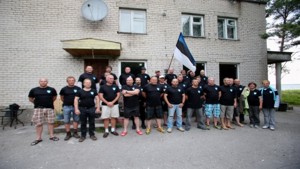 ERR – Although July 2013 has gone into the books without any earth-shaking events, this week marks the 20th anniversary of the culmination of a crisis that seems unthinkable today.
ERR – Although July 2013 has gone into the books without any earth-shaking events, this week marks the 20th anniversary of the culmination of a crisis that seems unthinkable today.
Back then, coup and secession – now concepts seemingly confined to North Africa – didn’t seem outside the realm of possibility in an era when Estonia, in the words of journalist Ainar Ruussaar, was “free but not finished.”
“It’s mystifying, the luck that Estonia has had,” Ruussaar said on the July 22 edition of Pressiklubi, a show he hosts on Kuku Raadio. “Just consider that in July a group of armed men were not obeying orders from the central government.”
A volunteer formation in the Estonian Army, the Jäägrikompanii, was ordered by the central government to quarter in Paldiski, back then a closed city with a nuclear submarine reactor and a large number of Soviet troops.
The mutinous company has already played an unsavory vigilante role in “cleaning up” Russian mafia elements. Some senior Defence Forces officials appeared eager to hamper the offensive against the Soviet Army, which would not leave Estonia until August 1994.
Journalist Andres Raid, who has written a book about the era, “When Estonia Was on the Brink of Civil War,” was on the Pressiklubi panel. He said that one of those who goaded the company on was Ants Laaneots, later commander in chief of the Defence Forces who himself had had a long career in the Soviet forces.
The group demurred, and requartered to Pullapää, in Lääne County, where it appeared ready for an armed standoff with the government.
In the end, the Pullapää Crisis, as it came to be called, resulted in high-level resignations and arrests and one non-fatal shootout in the fall. But no conflict took place – and certainly nothing that would have precipitated intervention from Moscow.
Also that month, three cities in the northeast, where the population is mainly ethnic Russian, held a referendum for autonomy. Over half of Narva residents voted to break away from Tallinn, along with over 95 percent of those in Sillamäe and Kohtla-Järve.
Miners who were part of the Narva Power Plant trade union had warned that there would be bloodshed, recalled Ruussaar.
But the secessionist moods in the northeast also dissipated with time.
Why? Marek Strandberg, a politician who figured in many of the dealings in the period, sought answers in national character and slow reaction time: “One main feature, if you read the pre-World War II descriptions of the people, is our drowsiness. People are sleepy, people forget insults, they are a little late. It is like our national epic hero Kalevipoeg. He is late, sometimes he is sleeping.”
“One main feature, if you read the pre-World War II descriptions of the people, is our drowsiness. People are sleepy, people forget insults, they are a little late. It is like our national epic hero Kalevipoeg. He is late, sometimes he is sleeping.”
“And very often he’s drinking as the enemy is stealing up behind him,” Raid chipped in.
“We have slept through many things where other, more temperamental people would be rising up,” Strandberg went on.
Ruussaar also credited Russia for not being vigilant. “How much can we thank God that Russia was the way it was in 1993: corrupt to the core, ruled by bandits, Yeltsin three sheets to the wind. No one was really paying attention to the Baltic front back then,” he said.
















